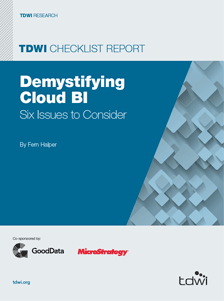
August 14, 2014
This Checklist Report focuses on helping organizations demystify several cloud BI issues. It examines the models emerging as
companies adopt the cloud.
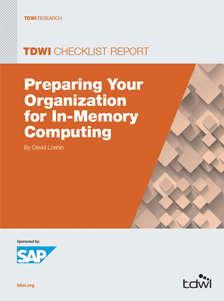
August 7, 2014
This TDWI Checklist Report will help your organization prepare for in-memory computing by discussing how it improves application performance. In-memory computing enables the peaceful coexistence of transaction processing and analytics without demanding data extraction, transformations, rampant replication, and heterogeneous computing platforms.
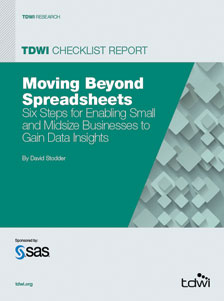
August 1, 2014
This TDWI Checklist Report details six areas where small and midsize businesses (SMBs) should focus as they move beyond spreadsheets to improve capabilities for gaining data insights.
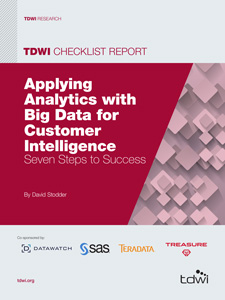
July 15, 2014
Big data analytics is about applying advanced methods and technologies to derive insights from very large and diverse data sets that often include varied data types and streaming data. This TDWI Checklist Report discusses steps for realizing value from big data and analytics for better customer intelligence.
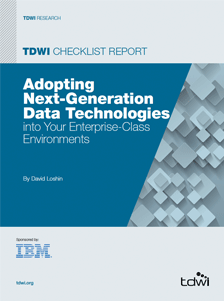
June 26, 2014
Tools from new vendors incorporating new big data technologies (such as Hadoop) for distributed and parallel computing and NoSQL data management are rapidly being evaluated and brought into
organizations. At the same time, numerous vendors of traditional platforms are offering the same or similar new technologies that are more robust and have more enterprise-ready capabilities than the new technologies can provide. This Checklist Report offers several important items to consider for your data management infrastructure, whether your implementation is on-premises, in the cloud, or a hybrid.
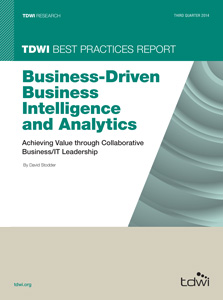
June 25, 2014
Download this report to learn how business-side leadership can step up to ensure that chaos does not reign in the era of less direct IT involvement, and provide direction for the adoption of new technologies and practices for the betterment of the enterprise as a whole.
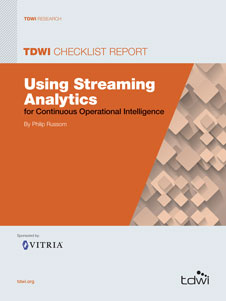
May 30, 2014
This TDWI Checklist Report examines the user best practices and vendor tool functions for analyzing streaming data, with a focus on those that enable new applications in continuous operational intelligence.
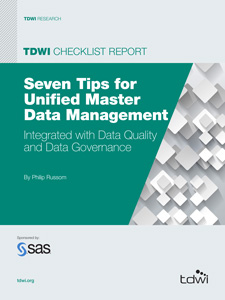
May 13, 2014
Master data management (MDM) can be practiced many different ways, with various user conventions and a broad array of vendor-built technologies. However, this report focuses on a specific practice called unified MDM, and examines the characteristics typical of business programs and technical solutions for unified MDM.
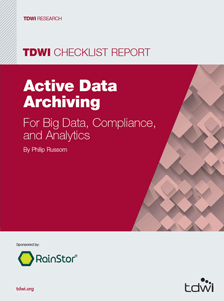
May 6, 2014
Users must start planning today for active data archiving. To help them prepare, this TDWI Checklist report will drill into the desirable attributes, use cases, user best practices, and enabling technologies of active data archiving.

April 28, 2014
Following TDWI’s previous Checklist Report on this topic, How to Gain Insight from Text, this Checklist discusses the relevance of text analytics for improving user experiences with the semi-structured and unstructured textual big data now at their disposal.
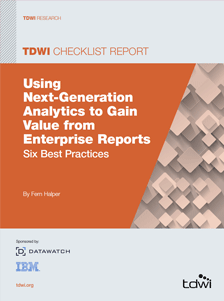
April 9, 2014
New techniques are emerging to help business analysts automate the extraction of information from reports stored in enterprise content management systems and use it for analysis. This Checklist Report focuses on helping organizations understand how to get started with report analysis.
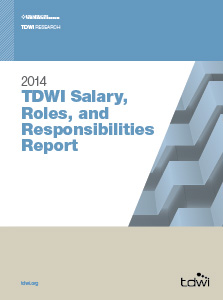
March 17, 2014
Average salaries rose 1.2 percent in 2013 for U.S. BI professionals. Read more in the 2014 TDWI Salary, Roles, and Responsibilities Report.
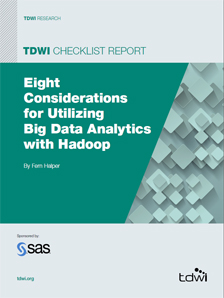
March 10, 2014
As enterprises look to embrace big data and Hadoop, they have numerous questions about data preparation, visualization, available analytical techniques, in-memory processing, and more. This Checklist Report focuses on these questions and provides information to help you explore big data analytics with Hadoop.
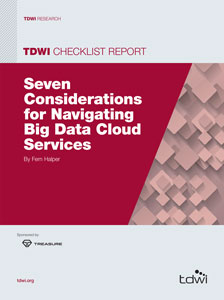
February 18, 2014
This Checklist Report focuses on helping organizations understand key considerations and best practices for utilizing cloud services for big data.
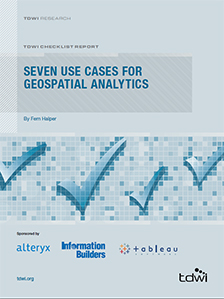
December 11, 2013
Geospatial information can be extremely helpful in a variety of analytics ranging from marketing to operations management. This checklist introduces readers to the range of use cases where geospatial analytics is being used today to support analysis.
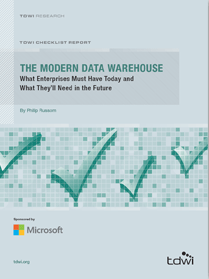
November 18, 2013
For organizations that need a modern data warehouse that satisfies new and future requirements, we offer a checklist of our top six recommendations. These can guide your selection of vendor products and your solution design.
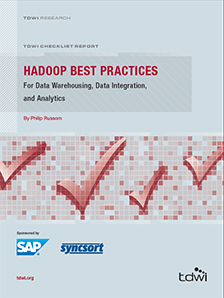
October 29, 2013
This checklist of best practices can help users make sustainable decisions as they plan their first Hadoop deployments.
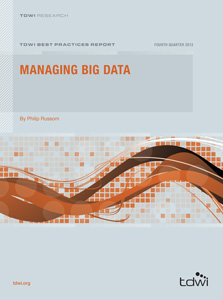
October 1, 2013
This Best Practices Report examines how organizations are leveraging their big data assets, the challenges they face, future trends in user practices and vendor tools, and 10 priorities for the years ahead.
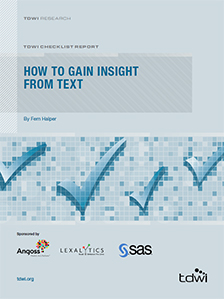
September 17, 2013
This TDWI Checklist Report takes a look at text analytics and how to get started with this new technology that can help you improve and gain new insight.
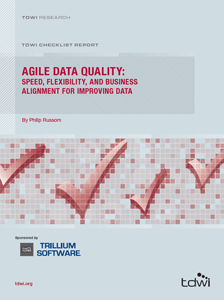
June 17, 2013
This TDWI Checklist Report discusses how organizations can achieve greater agility with data quality projects through adjustments to data stewardship, business processes, and technical development methods. The report also looks at critical success factors for agile
data quality, such as tool features, team structures, self service, data-driven documentation, and data services.
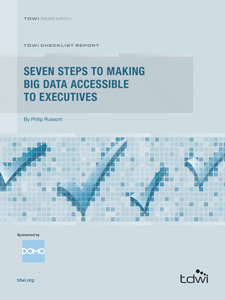
March 27, 2013
This TDWI Checklist Report describes a BI environment and its attendant best practices that can greatly simplify executives’ access to big data and enhance their consumption of insights and metrics that come out of big data and similar data sets.

March 18, 2013
The TDWI Salary, Roles, and Responsibilities Report provides an overview of compensation, roles, responsibilities, skills, experience, training, and job satisfaction of industry professionals, and also takes an in-depth look at the profiles of 10 specific roles.
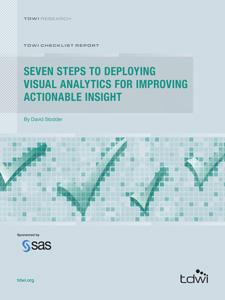
March 15, 2013
This TDWI Checklist Report details seven steps for successful visual analytics intended to help organizations develop strategies for improving actionable insight to a growing population of users.
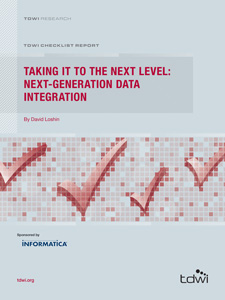
March 1, 2013
The next generation of data integration seamlessly combines streamlined development with fully integrated
data accessibility, quality, and utility. This report presents a series of recommendations for developing a value justification for engaging business sponsors, as well as developing a strategic IT road map promoting the value of data architecture and data integration.
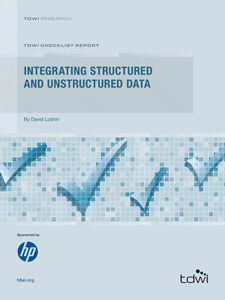
February 11, 2013
The challenge of integrating structured and unstructured data will be a key factor for big data success. This report examines key planning directives and helps scope best practices for integrating structured and unstructured data as critical tactical components of a modern information strategy.
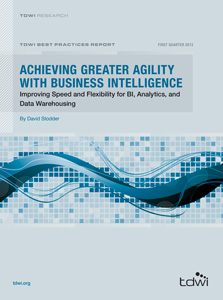
January 4, 2013
The information that flows from BI, analytics, and data warehousing systems can help organizations find a decision-making balance that avoids the extremes of snap decisions and rigid processes. This new survey-based research report examines benefits, barriers, technology solutions, and recommendations for achieving greater agility with business intelligence.
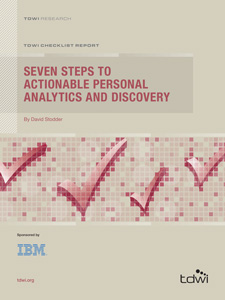
October 16, 2012
Organizations today want to anchor daily and strategic decisions in a bedrock of solid, extensive, and timely analysis and reporting. Personal, self-service BI and analytics tools are now available that can give users more control over how they view and access the information they need to perform their roles in the enterprise. This TDWI Checklist Report details seven steps toward personal BI and analytics success.
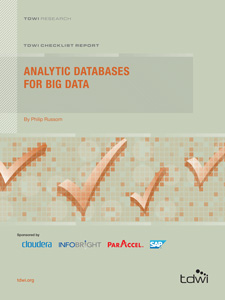
October 4, 2012
This report presents a requirements checklist for analytic DBMSs with a focus on their use with big data. You will also learn definitions for the many techniques and tool types involved. The report will help you evaluate analytic databases and/or develop strategies for big data analytics.
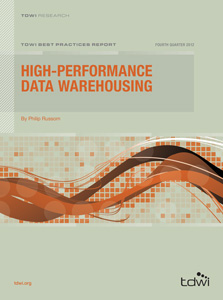
October 1, 2012
In the age of "big data," high-performance data warehousing is primarily about achieving speed and scale while also coping with increasing complexity and concurrency. The tips and strategies presented in this research can help user organizations prioritize their acquisition of vendor tools and their adoption of design best practices.
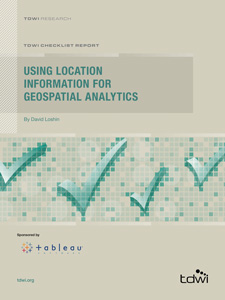
September 26, 2012
This TDWI Checklist Report presents tips for aligning geospatial information with the business intelligence environment, empowering analytics to use location data to yield operational efficiencies, revenue growth, and other potential benefits.
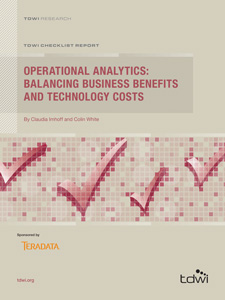
September 5, 2012
This TDWI Checklist Report examines the business drivers and technology requirements for deploying operational analytics. The main objectives of the Checklist are to identify specific business benefits of operational analytics, review the ways these benefits can be achieved, and explain the potential trade-offs or IT costs involved.
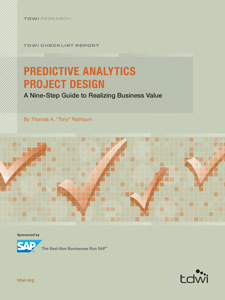
July 12, 2012
Ultimately, the effective utilization of predictive analytics is the goal-driven analysis of data to enhance business performance metrics. This TDWI Checklist Report examines the strategic steps that predictive analytics project teams must take in order to define, design, and implement successful projects.
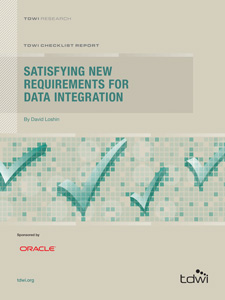
June 27, 2012
Mounds of structured data, unstructured data, big data, and advancements in cloud technology are imposing new requirements for data integration. This TDWI Checklist Report will explore some of the key drivers these new requirements are intended to address. Whether you are looking to support the performance needs of big data applications, filter concepts from unstructured data, monitor hundreds of data feeds for unexpected behavior, export data across enterprise boundaries, or provide real-time reporting and analysis, there is a rapidly expanding need for data integration competency that extends well beyond traditional ETL.
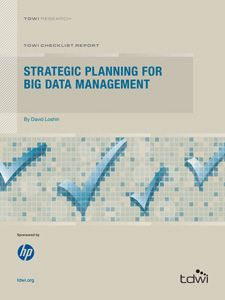
May 9, 2012
This TDWI Checklist Report provides grounding for developing a strategic business intelligence (BI) plan for agility when adopting innovative data management and utilization techniques, while retaining a line of sight to corporate mission and corresponding business objectives.
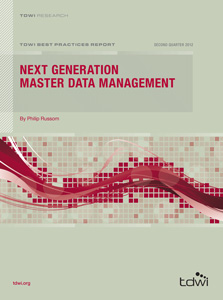
April 2, 2012
Master data management (MDM) is one of the most widely adopted data management disciplines of recent years. This report accelerates users’ understanding of the many new user best practices, solutions, and tools that have emerged as next generation MDM. It also helps readers map their options to real-world use cases and develop a strategy for MDM.
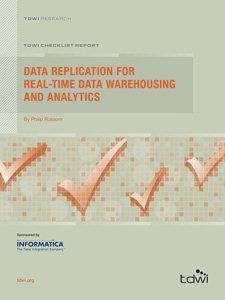
April 2, 2012
This TDWI Checklist Report gives data replication the recognition it deserves, as a highly useful data integration technique for real-world applications in business intelligence (BI), data warehousing (DW), analytics, and general data management. But not all replication tools are created equal, and this report explains which capabilities you should look for in a tool.
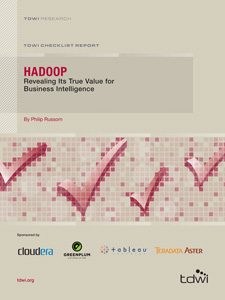
December 13, 2011
This Checklist Report clarifies the common points of confusion about Hadoop and its extended ecosystem and reveals the true value of Hadoop for BI, DW, big data, and analytics.
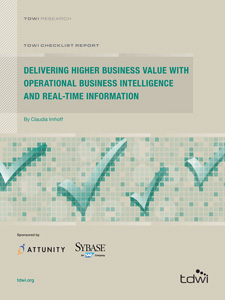
November 29, 2011
This Checklist Report examines the issues surrounding operational and real-time BI and helps you determine how to align their implementation with true business requirements and capabilities, to ensure greater success in reaching business and IT goals.
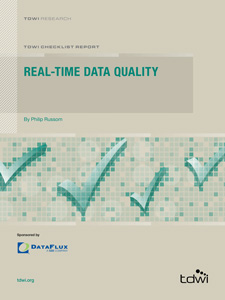
November 7, 2011
This TDWI Checklist Report drills into the details and desirable use cases for real-time data quality (RT DQ) to help user organizations understand what’s available and when to use it.
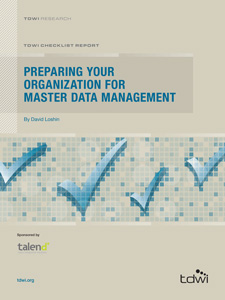
October 18, 2011
This TDWI Checklist Report reviews opportunities where anticipating potential roadblocks can help improve planning, identify issues early in the program, and generally eliminate barriers to master data management (MDM) success.
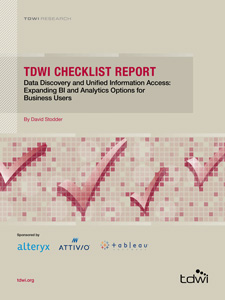
August 7, 2011
This Checklist Report focuses on helping organizations understand how data discovery and UIA tools address new requirements for data access, reporting, and analytics, particularly for nontechnical users in lines of business and operations.
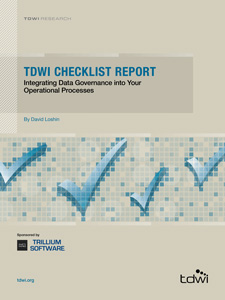
August 5, 2011
This TDWI Checklist Report details recommendations that connect high-level policies to specific actions, and shows the ways that data governance tasks can be integrated into existing operational processes. Following the items on this Checklist will energize your data governance program and ensure its integration within operational workflows.
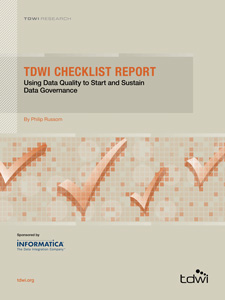
July 26, 2011
This TDWI Checklist Report makes a case for applying data quality (DQ) techniques and best practices to data governance (DG) as a way of kick-starting and sustaining data governance.
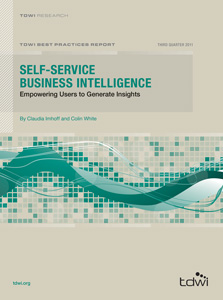
July 1, 2011
In today's economic environment, organizations must use business intelligence (BI) to make smarter, faster decisions. Yet, in too many organizations, decisions are still not based on business intelligence because of the inability to keep up with demand for information and analytics. To satisfy this demand, one approach involves setting up a self-service BI (SS BI) environment.
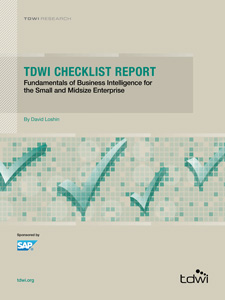
June 20, 2011
This TDWI Checklist Report describes the fundamental aspects of BI that are necessary to help small and midsize enterprises achieve scalability by revealing new business opportunities, enabling rapid response to emerging issues, and continuously monitoring business success.
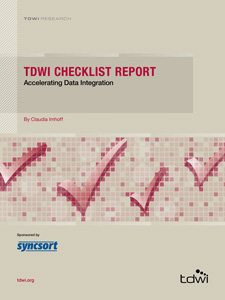
May 31, 2011
This TDWI Checklist Report helps you determine if your data integration environment has performance issues. It describes alternative solutions and includes the pros and cons for each.
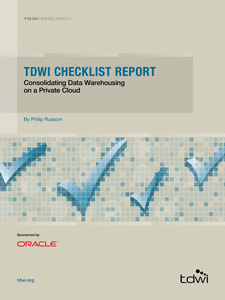
May 10, 2011
This TDWI Checklist Report makes a case for private database clouds, especially as a platform for consolidated BI and DW applications.
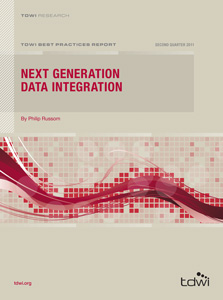
April 1, 2011
Data integration (DI) has undergone an impressive evolution in recent years. Today, DI is a rich set of powerful techniques, including ETL (extract, transform, and load), data federation, replication, synchronization, changed data capture, data quality, master data management, natural language processing, business-to-business data exchange, and more. This report brings readers up to date on all that's happening in this exciting arena of data management.
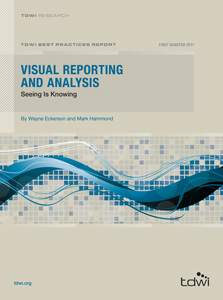
January 3, 2011
Data visualization is increasingly an essential element of
business intelligence (BI). No longer restricted to specialized
applications, data visualization in the form of charts, maps,
and other graphical representations is enabling business
users to better understand data and use it to achieve tactical
and strategic objectives.

October 29, 2010
If your organization is among the vast majority of businesses looking to implement real-time data warehousing or data integration functions, download this report for a practical look at some critical questions.

August 16, 2010
This TDWI Checklist Report explains how to provide justification for time and money invested in metadata management solutions.
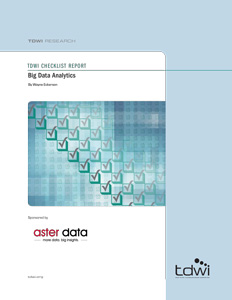
August 10, 2010
This TDWI Checklist Report is designed to provide a basic set of guidelines for implementing big data analytics.